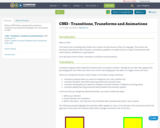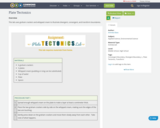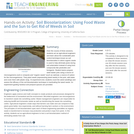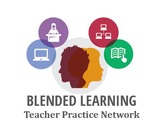
What is CSS3? Some examples like transitions, transforms and animations highlights the new features of CSS3.
- Subject:
- Applied Science
- Computer Science
- Material Type:
- Student Guide
- Date Added:
- 01/18/2019

What is CSS3? Some examples like transitions, transforms and animations highlights the new features of CSS3.

In this class, food serves as both the subject and the object of historical analysis. As a subject, food has been transformed over the last 100 years, largely as a result of ever more elaborate scientific and technological innovations. From a need to preserve surplus foods for leaner times grew an elaborate array of techniques – drying, freezing, canning, salting, etc – that changed not only what people ate, but how far they could/had to travel, the space in which they lived, their relations with neighbors and relatives, and most of all, their place in the economic order of things. The role of capitalism in supporting and extending food preservation and development was fundamental. As an object, food offers us a way into cultural, political, economic, and techno-scientific history. Long ignored by historians of science and technology, food offers a rich source for exploring, e.g., the creation and maintenance of mass-production techniques, industrial farming initiatives, the politics of consumption, vertical integration of business firms, globalization, changing race and gender identities, labor movements, and so forth. How is food different in these contexts, from other sorts of industrial goods? What does the trip from farm to table tell us about American culture and history?

This activity introduces students to using Google Earth and adding layers to google earth, while re-enforcing plate tectonic concepts and evidence for plate tectonics.
Outcomes:
1. Download Google Earth onto computer
2. Turn on/off layers within Google Earth
3. Be able to change measurement and use ruler within Google Earth
4. Determine latitude and longitude of ocean basin features
5. Be able to search for locations within Google Earth
6. Learn to upload new layers into Google Earth from .kmz files
7. Describe different plate boundaries, their locations and boundary interactions
8. Explain evidence for Plate Tectonics

This resource is a video abstract of a research paper created by Research Square on behalf of its authors. It provides a synopsis that's easy to understand, and can be used to introduce the topics it covers to students, researchers, and the general public. The video's transcript is also provided in full, with a portion provided below for preview:
"Reproducibility is extremely important in science. But no matter how much effort is put into standardizing protocols, small differences seem inevitable in the way experiments are performed among laboratories. These small differences can add up to discrepancies that complicate data interpretation. One field where this issue looms large is neuroscience – particularly in experiments involving histological sections of the mouse brain. Such studies require correct identification of specific brain regions for accurate interpretation of results. But the mouse brain is small and complex. Brain atlases can be invaluable in mapping, but applying this information in laboratory experiments is difficult. A new automated system aims to solve this problem by taking the guesswork – and potential observer error and bias – out of the equation. Much like a GPS system in a car, the program – called NeuroInfo – helps researchers navigate through the microscopic anatomy of a brain section..."
The rest of the transcript, along with a link to the research itself, is available on the resource itself.

This lab uses graham crackers and whipped cream to illustrate divergent, convergent, and transform boundaries.

Over the course of three sessions, students act as agricultural engineers and learn about the sustainable pest control technique known as soil biosolarization in which organic waste is used to help eliminate pests during soil solarization instead of using toxic compounds like pesticides and fumigants. Student teams prepare seed starter pots using a source of microorganisms (soil or compost) and “organic waste” (such as oatmeal, a source of carbon for the microorganisms). They plant seeds (representing weed seeds) in the pots, add water and cover them with plastic wrap. At experiment end, students count the weed seedlings and assess the efficacy of the soil biosolarization technique in inactivating the weed seeds. An experiment-guiding handout and pre/post quizzes are provided.

This resource is a video abstract of a research paper created by Research Square on behalf of its authors. It provides a synopsis that's easy to understand, and can be used to introduce the topics it covers to students, researchers, and the general public. The video's transcript is also provided in full, with a portion provided below for preview:
"Kidney transplant patients currently require life-long treatment with immunosuppressive drugs to prevent their body from rejecting the transplanted organ. Immunosuppression can have side effects such as an increased risk of infections or developing comorbidities such as new onset diabetes or certain malignancies. Other side effects are related to the drugs’ toxicity, such as kidney damage, ultimately leading to a return to dialysis or need for re-transplant. A clinical trial, TRANSFORM, was carried out to test a new immunosuppressive regimen consisting of everolimus plus low-dose CNI, versus the current standard-of-care regimen: mycophenolic acid plus the standard, higher dose of CNI. The two-year results of this trial showed that the combination of everolimus plus low CNI had a similar ability to prevent kidney rejection or severe kidney impairment as the current standard-of-care regimen..."
The rest of the transcript, along with a link to the research itself, is available on the resource itself.

These artifacts made headlines in their day and helped transform our world and make our planet smaller and our universe even larger.

After researching and learning about the possible devastation that would ensue if the Supervolcano at Yellowstone National Park were to erupt, students will work together in this problem-based learning module to use the information to create a news report to inform American citizens of the effects that would ensure in the event of an eruption. When creating the news report, students will be asked to think of a way to capture their audience attention about the topic while still explaining the science behind what is happening at this site. Students will also take the role of a number of different characters (i.e. experts in the field, scientists, concerned citizens, news caster etc.), and show at least one powerful image to aid in telling the story. After the Launch of the activity, students will take time to explore a variety of resources about this topic that will aid them in answering the “need to know” questions needed to create their News. These items should be shared with the students electronically in a collective folder, and students will be asked to gather the information at their own pace.Once students have completed their news story, students will present their final products to an authentic audience consisting of district Administration, and building staff members.